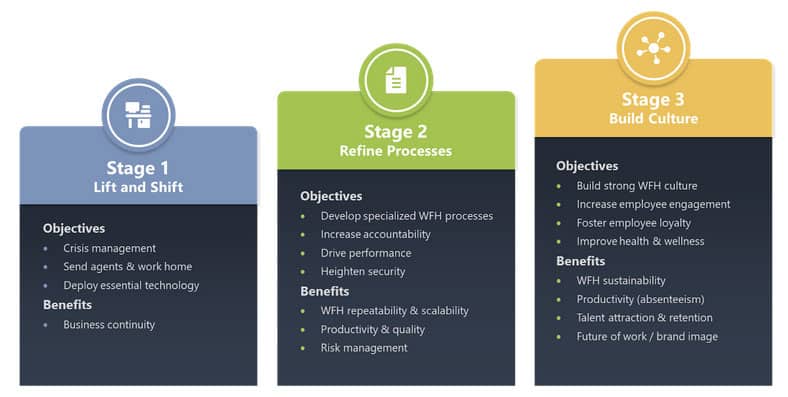The Evolution And Future Of Remote Work

Even as some economies are cautiously reopening since COVID-19 upended life as we know it, companies are not rushing to send employees back to their office buildings. Google, Facebook, Capital One, Twitter, and Zillow are among a growing number extending their work-from-home (WFH) policies far beyond required time periods (indeed, Twitter employees may WFH “forever” if they choose).
Among the reasons given are allowing time for companies to ensure safe workspaces for when employees do return to offices and giving workers sufficient leeway for adapting to new post-COVID realities. But there is another perhaps more surprising reason: So far, working from home has been working out well.
This revelation, reported in The New York Times, is consistent with conversations I’ve had with numerous business leaders now weighing the feasibility of WFH for the long haul. As a society we’ve always understood the significant advantages of remote work: The ability to hire great people regardless of where they live, improved quality of life (on average, we spend 6 weeks per year commuting to and from the office), more time with family, reduced carbon footprint, billions in potential real estate savings, the list of benefits goes on.
Yet we didn’t embrace remote work at scale. According to Global Workplace Analytics, 56% of the U.S. workforce holds a job that is compatible with remote work, yet prior to COVID-19, only 3.6% worked at home half-time or more. Why?
In my opinion, the two big determining factors are 1) social connection, and 2) trust. The remote model does not naturally lend itself to either, and if we don’t address both directly then our global experiment in remote work won’t last.
Social connection at work, which fosters collaboration, team productivity, a sense of belonging and loyalty, and improved mental and physical health, is universally acknowledged as important. In practice, however, employee engagement and culture-building are often shortchanged in the remote environment or approached in an ad-hoc fashion. This is especially true with many firms that are new to home-based work.
Trust, on the other hand, is not widely acknowledged but has arguably been the strongest headwind against the widespread adoption of remote work. It’s the elephant in the room people don’t want to talk about. With increased physical distance and the resulting lack of transparency, both trust and cooperation decline measurably. Phrases like “seeing is believing” and “out of sight, out of mind” are supported by multiple studies, yet few organizations have been willing to engage in honest conversations with their employees about the implications.
Where do we go from here, now that millions are working remotely for the first time? The future largely depends on how we evolve our approach to remote work in order to address these fundamental challenges.
In my experience, there are three primary stages of evolution that each organization will experience in their remote work journey:
- Lift and Shift (where many are today)
- Refine Processes
- Build Culture
Leadership that understands the importance of the last stage, where the focus shifts to building culture and connection, will have the greatest long-term success with the remote model.
The first stage, where many newcomers are today, we call Lift and Shift (the name says it all). This is getting the workers, and their work, sent home and getting them set up on basic technology like Zoom, Teams, Slack, etc., to keep them minimally productive. For some organizations, the effort of rapidly moving thousands to home offices virtually overnight was herculean. Although painful, outcomes largely exceeded expectations, and these companies justifiably declared victory. Similar transitions occurred globally, even in emerging markets where just months ago remote work at scale was considered laughable. For example, one firm with call center operations in the Philippines actually went desk-by-desk with bolt cutters to untether computers so workers could take them home overnight.
The second stage is where organizations start to get serious about a longer-term remote strategy by focusing on productivity and accountability. Here is where employers can begin to unlock the full potential of remote by: 1) putting in place systems and processes that drive performance from all employees, not just top performers, and 2) abandoning the traditional hub-and-spoke model in favor of a national or even global talent acquisition strategy. Traditionally, employers have followed a “remote-as-reward” approach, giving top performers the option to work from home after several months or years of proving themselves. Moving to a “remote-first” environment where even low performers are in the home office means getting more deliberate and intentional about virtual training, coaching and development, performance metrics, and general accountability. In terms of talent acquisition, untethering from corporate offices and hiring talent wherever they live expands the labor pool by 10 to 100 times – a significant way to upskill the workforce. Lastly, during this stage, organizations are also implementing stronger security measures, largely through the adoption of new technologies designed to safeguard data and intellectual property.
Finally, in the interest of cementing both social connection and trust, it is essential to address one of the biggest obstacles to widespread WFH adoption—the potential for social isolation and loneliness. Building a strong remote culture where employees stay connected and engaged can be a challenge, particularly in an untethered model where new hires don’t have the opportunity to bond in person during the onboarding process. At BroadPath, we have been working hard on this third evolutionary stage by developing new technology and programs that create a sense of community and belonging. Firms that invest significant resources to enhance virtual connection, collaboration, and team bonding will be positioned to reap the greatest long-term rewards from the remote model and will enjoy employer-of-choice status as the economy and employment rebound in the months to come.
Overall, there is strong and growing interest in making this global WFH experiment a longer-term reality. Many clients (in our relatively conservative industry) aspire to maintain 30-60% of their employees working from home long-term. Now that we have won the short-term battle of getting workers home, we need to get serious about how to make it stick.
Written by Daron Robertson. Here’s what you’ve missed?
World’s Best Countries For Education System.
World’s Best Countries For A Child To Be Born In.
World’s Best Hospitality And Hotel Management Schools.
Bring the best of the CEOWORLD magazine's global journalism to audiences in the United States and around the world. - Add CEOWORLD magazine to your Google News feed.
Follow CEOWORLD magazine headlines on: Google News, LinkedIn, Twitter, and Facebook.
Copyright 2025 The CEOWORLD magazine. All rights reserved. This material (and any extract from it) must not be copied, redistributed or placed on any website, without CEOWORLD magazine' prior written consent. For media queries, please contact: info@ceoworld.biz









